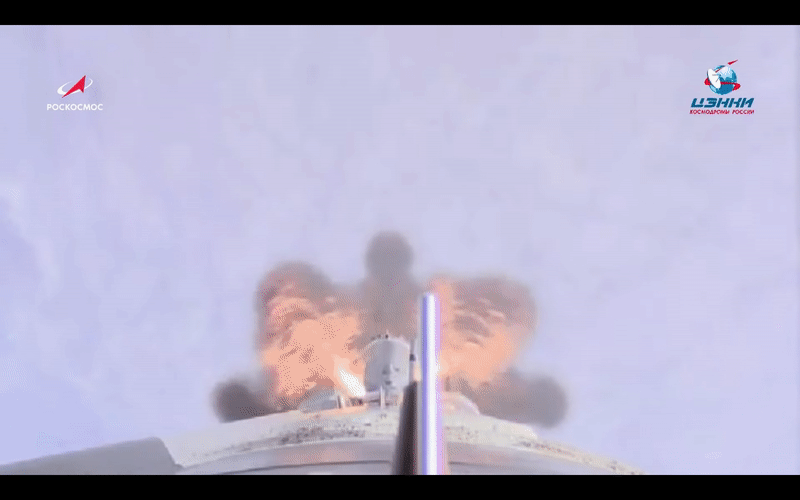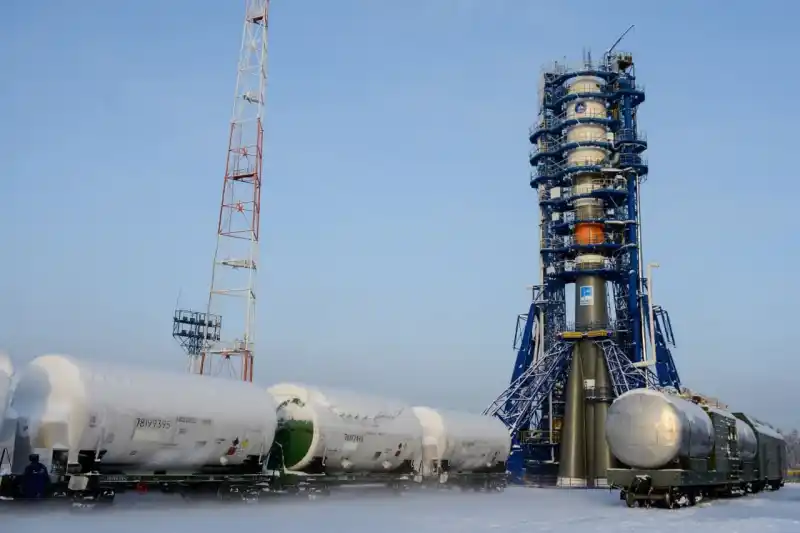Featured image credit: Ministry of Defense of the Russian Federation
Lift Off Time | February 5, 2022 – 07:00 UTC | 10:00 MSK |
|---|---|
Mission Name | Kosmos 2553, a classified mission for the Ministry of Defense of the Russian Federation |
Launch Provider | ROSCOSMOS |
Customer | Ministry of Defense of the Russian Federation |
Rocket | Soyuz 2.1a |
Launch Location | Site 43, Pad 4, Plesetsk Cosmodrome, Russia |
Payload mass | Due to the classified nature of this payload, it cannot be specified |
Where did the satellite go? | Due to the classified nature of this payload, it cannot be specified |
Did they attempt to recover the first stage? | No, Soyuz is not capable of recovery |
Where did the first stage land? | It crashed on the territory of Yamalo-Nenets Autonomous Okrug |
Did they attempt to recover the fairings? | No, Soyuz is not capable of recovery |
Were these fairings new? | Yes |
This was the: | – 1st launch of Soyuz 2.1a of 2022 – 1st launch from the Plesetsk cosmodrome in 2022 – 11th orbital launch attempt of 2022 (11th successful) |
Where to re-watch | If an official replay is available, it will be listed here |
How Did It Go?
ROSCOSMOS successfully launched a military satellite on a Soyuz 2.1a launch vehicle for the Ministry of Defense of the Russian Federation. Initially, this launch was planned for February 3, 2022, but then rescheduled for February 5. The rocket lifted off uneventfully on February 5, 2022, from the Plesetsk Cosmodrome, in Russia. The satellite was assigned the serial number “Kosmos-2553”. This mission marks the first launch of the Soyuz 2.1a rocket of this year.
Kosmos 2553 Mission
Due to the classified nature of this mission, nothing is known about the characteristics of the satellite. ROSCOSMOS reported that the launch went smoothly. The Titov Main Test and Space Systems Control Centre were responsible for ground control operations. A stable telemetry connection has been established and maintained with the satellite, it is reported that its onboard systems are operating as expected. The Kosmos 2553 satellite is equipped with newly developed on-board instruments that will be tested during this mission.
What Is Soyuz 2.1a?
ROSCOSMOS’s Soyuz is a multi-use medium-lift launch vehicle that was introduced in 1966 and since then has been the workhorse of the Soviet/Russian space program. It is able to launch civilian and military satellites, as well as cargo and crewed missions to the ISS. Over the decades, several variants of the Soyuz rocket have been developed. Soyuz 2.1a is one of its latest iterations that belongs to the Soyuz-2 rocket family.

The rocket consists of three stages, all of them are expendable. When launching to the ISS, Soyuz-2 can be flown with either a Progress capsule or a Soyuz spacecraft.
Soyuz 2.1a is about 46.3 meters (152 ft) in height and 2.95 meters (9 feet) in diameter. The vehicle’s total lift-off mass is approximately 312,000 kg (688,000 lb). The rocket’s payload lift capacity to low-Earth orbit (LEO) is between 6,600 and 7,400 kg depending on the launch site.
Stages
| First Stage | Second Stage | Third Stage | |
| Engine | 4 RD-107A | RD-108A | RD-0110 |
| Total Thrust | 840 kN (188,720 lbf), sea level 1,020 kN (229,290 lbf), vacuum | 792 kN (178,140 lbf), sea level 922 kN (207,240 lbf), vacuum | 298 kN (67,000 lbf), vacuum |
| Specific Impulse (ISP) | 263 s, sea level 320 s, vacuum | 258 s, sea level 321 s, vacuum | 326 s, vacuum |
Side Boosters
The first stage of the Soyuz 2.1a rocket is composed of four side boosters that are powered by RD-107A engines. Each one of the boosters has a conical shape and a dry weight of 3,784 kg. It is approximately 19.6 meters in length, with a diameter of 2.7 meters. Each side booster has two vernier thrusters that are used for flight control.
The RD-107A engine runs on rocket-grade kerosene (RP-1) and liquid oxygen (LOx). The propellants are stored in the pressurized aluminum alloy tanks, the kerosene tank is located in the cylindrical part of the booster, and the LOx tank is in the conical section. Each one of those engines has four combustion chambers and together they are capable of producing a thrust of 840 kN at sea level and 1,020 kN in a vacuum.

Perhaps, the most spectacular moment of the Soyuz-2 rocket’s launch is the separation of the first stage. It happens approximately two minutes after the launch. The boosters perform a pattern, known as the “Korolev cross” (named after Sergei Korolev, a very important figure of the USSR space program and history).
Second And Third Stages
The center core stage is powered by a single RD-108A engine, and the upper stage is fitted with a single RD-0110 engine. Both of these engines run on rocket-grade kerosene and LOx and have four combustion chambers. The second stage is 27.10 meters long, with a diameter of 2.95 meters, and a dry mass of 6,545 kg. It has four vernier thrusters for three-axis flight control.
The third stage of a Soyuz-2 rocket has a height of 6.7 meters, a diameter of 2.7 meters, and a dry mass of 2,355 kg. One interesting thing about the engine on this stage is that it starts its ignition sequence prior to stage separation. This process is called “hot fire staging”.
Fregat-M Upper Stage
Flight qualified in 2000, the Fregat upper stage is an autonomous and flexible stage that is designed to operate as an orbital vehicle. It extends the Soyuz launcher’s capability, covering a full range of orbits (LEO, SSO, MEO, GTO, GEO and Earth escape). Fregat is independent of all the other stages, as it has its own guidance, navigation, attitude control, tracking, and telemetry systems. The S5.92 engine burns storable propellants – UDMH (unsymmetrical dimethylhydrazine) and NTO (nitrogen tetroxide). The Fregat upper stage is encapsulated in a fairing with the payload and a payload adaptor/dispenser. Upgraded Fregat-M has additional ball-shaped compartments on top of its propellant tanks, which allows to increase the load capability of the propellant.





